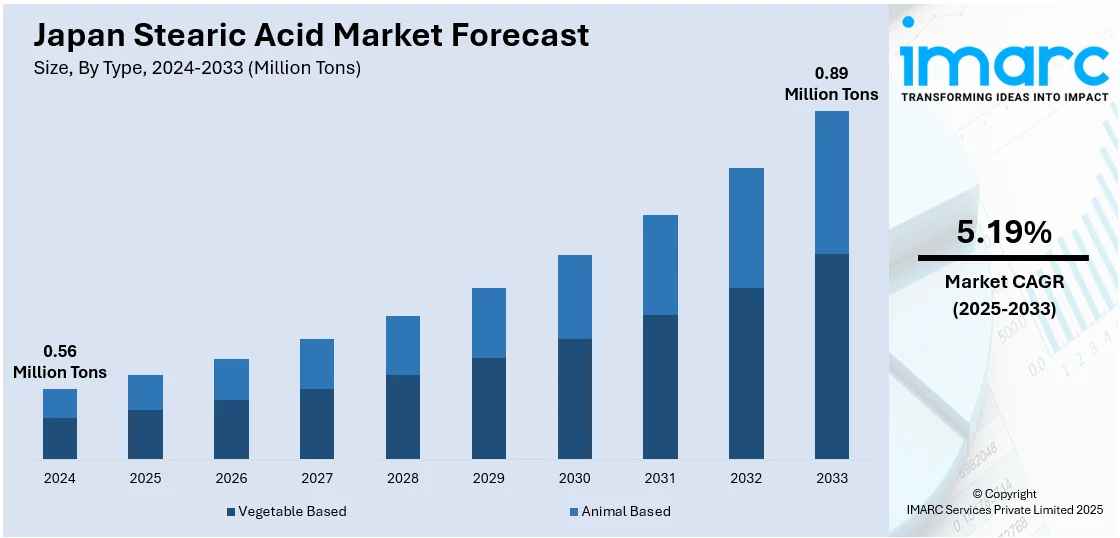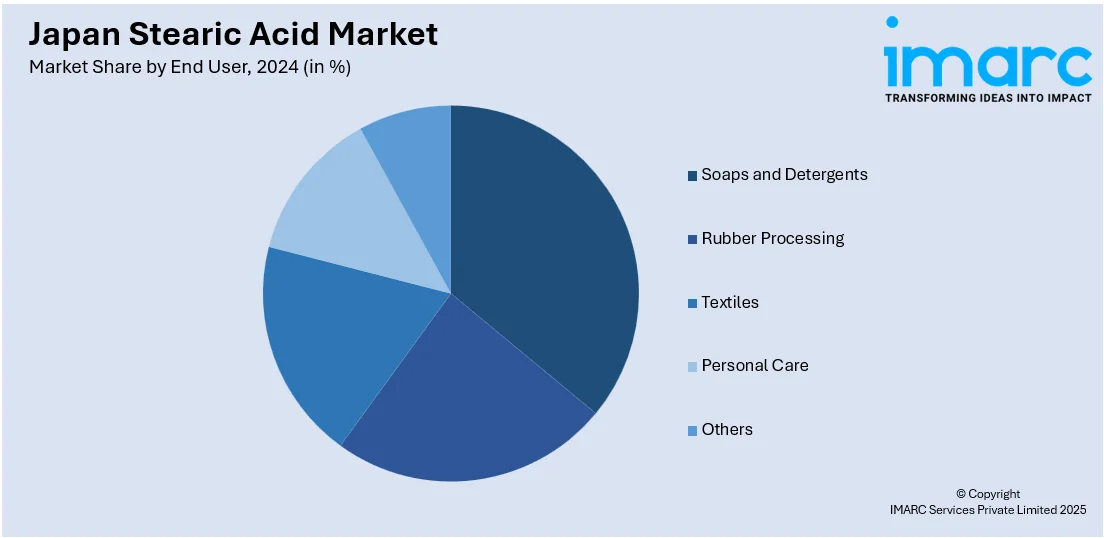
Japan Stearic Acid Market Size, Share, Trends and Forecast by Type, End User, and Region, 2025-2033
Japan Stearic Acid Market Overview:
The Japan stearic acid market size reached 0.56 Million Tons in 2024. Looking forward, IMARC Group expects the market to reach 0.89 Million Tons by 2033, exhibiting a growth rate (CAGR) of 5.19% during 2025-2033. The escalating demand for personal care and cosmetic items is impelling the market growth. Besides this, the increasing focus on health and wellness, which is leading to a higher demand for prescription and over-the-counter (OTC) drugs, is contributing to the expansion of the Japan stearic acid market share.
|
Report Attribute
|
Key Statistics
|
|---|---|
|
Base Year
|
2024 |
|
Forecast Years
|
2025-2033
|
|
Historical Years
|
2019-2024
|
| Market Size in 2024 | 0.56 Million Tons |
| Market Forecast in 2033 | 0.89 Million Tons |
| Market Growth Rate 2025-2033 | 5.19% |
Japan Stearic Acid Market Trends:
Increasing demand for personal care and cosmetic items
Rising demand for personal care and cosmetic items is fueling the market growth. Stearic acid serves as an essential component in producing creams, lotions, soaps, shampoos, and cosmetics due to its thickening, stabilizing, and emulsifying characteristics. With individuals prioritizing skincare, anti-aging items, and personal grooming, companies are creating enhanced products that utilize stearic acid for superior texture and effectiveness. The rising trend of natural and organic cosmetics is creating the need for stearic acid sourced from plants. Moreover, the increasing availability of men's grooming products is enhancing the employment of stearic acid in numerous formulations. Cosmetic brands are focusing on creating soft, smooth, and luxurious-feeling products, and stearic acid helps achieve these qualities. The increasing awareness about quality, safety, and effectiveness among Japanese users is leading companies to choose reliable ingredients like stearic acid. As innovations in the personal care sector continue, and as user expectations are rising, the role of stearic acid is becoming critical.

Growing applications in rubber and plastics industry
Increasing applications of stearic acid in the rubber and plastics industry are positively influencing the market. Stearic acid acts as an important lubricant, softener, and release agent during the manufacturing of rubber products like tires, belts, and seals. It improves the flexibility, durability, and surface finish of these items, making it a key material in manufacturing. In the plastics industry, stearic acid aids in stabilizing and processing plastic resins, ensuring smoother operations and better-quality end products. As Japan’s automotive, electronics, and construction sectors are thriving, the demand for advanced rubber and plastic materials is rising. This is directly promoting the usage of stearic acid across factories and production units. The need for lightweight, durable, and high-performance materials is further strengthening its market position in Japan.
Rising need for pharmaceutical products
Increasing need for pharmaceutical products is impelling the Japan stearic acid market growth. Stearic acid acts as a lubricant and binding agent in the production of tablets and capsules, helping to improve their consistency, stability, and ease of swallowing. As Japan’s healthcare system is growing and the demand for medicines is rising, pharmaceutical companies are employing more high-quality ingredients like stearic acid to meet strict production standards. It aids in controlled-release formulations, which are gaining popularity for better patient outcomes. The need for efficient and smooth-running manufacturing processes is making stearic acid a preferred choice in pharmaceutical plants. In addition, the growing focus on health, wellness, and an aging population is increasing the utilization of both prescription and OTC drugs, further catalyzing the demand for stearic acid in Japan.
Japan Stearic Acid Market Segmentation:
IMARC Group provides an analysis of the key trends in each segment of the market, along with forecasts at the country and regional levels for 2025-2033. Our report has categorized the market based on type and end user.
Type Insights:
- Vegetable Based
- Animal Based
The report has provided a detailed breakup and analysis of the market based on the type. This includes vegetable based and animal based.
End User Insights:

- Soaps and Detergents
- Rubber Processing
- Textiles
- Personal Care
- Others
A detailed breakup and analysis of the market based on the end user have also been provided in the report. This includes soaps and detergents, rubber processing, textiles, personal care, and others.
Regional Insights:
- Kanto Region
- Kansai/Kinki Region
- Central/ Chubu Region
- Kyushu-Okinawa Region
- Tohoku Region
- Chugoku Region
- Hokkaido Region
- Shikoku Region
The report has also provided a comprehensive analysis of all the major regional markets, which include Kanto Region, Kansai/Kinki Region, Central/ Chubu Region, Kyushu-Okinawa Region, Tohoku Region, Chugoku Region, Hokkaido Region, and Shikoku Region.
Competitive Landscape:
The market research report has also provided a comprehensive analysis of the competitive landscape. Competitive analysis such as market structure, key player positioning, top winning strategies, competitive dashboard, and company evaluation quadrant has been covered in the report. Also, detailed profiles of all major companies have been provided.
Japan Stearic Acid Market Report Coverage:
| Report Features | Details |
|---|---|
| Base Year of the Analysis | 2024 |
| Historical Period | 2019-2024 |
| Forecast Period | 2025-2033 |
| Units | Million Tons |
| Scope of the Report |
Exploration of Historical Trends and Market Outlook, Industry Catalysts and Challenges, Segment-Wise Historical and Future Market Assessment:
|
| Types Covered | Vegetable Based, Animal Based |
| End Users Covered | Soaps and Detergents, Rubber Processing, Textiles, Personal Care, Others |
| Regions Covered | Kanto Region, Kansai/Kinki Region, Central/ Chubu Region, Kyushu-Okinawa Region, Tohoku Region, Chugoku Region, Hokkaido Region, Shikoku Region |
| Customization Scope | 10% Free Customization |
| Post-Sale Analyst Support | 10-12 Weeks |
| Delivery Format | PDF and Excel through Email (We can also provide the editable version of the report in PPT/Word format on special request) |
Key Questions Answered in This Report:
- How has the Japan stearic acid market performed so far and how will it perform in the coming years?
- What is the breakup of the Japan stearic acid market on the basis of type?
- What is the breakup of the Japan stearic acid market on the basis of end user?
- What is the breakup of the Japan stearic acid market on the basis of region?
- What are the various stages in the value chain of the Japan stearic acid market?
- What are the key driving factors and challenges in the Japan stearic acid market?
- What is the structure of the Japan stearic acid market and who are the key players?
- What is the degree of competition in the Japan stearic acid market?
Key Benefits for Stakeholders:
- IMARC’s industry report offers a comprehensive quantitative analysis of various market segments, historical and current market trends, market forecasts, and dynamics of the Japan stearic acid market from 2019-2033.
- The research report provides the latest information on the market drivers, challenges, and opportunities in the Japan stearic acid market.
- Porter's five forces analysis assist stakeholders in assessing the impact of new entrants, competitive rivalry, supplier power, buyer power, and the threat of substitution. It helps stakeholders to analyze the level of competition within the Japan stearic acid industry and its attractiveness.
- Competitive landscape allows stakeholders to understand their competitive environment and provides an insight into the current positions of key players in the market.
Need more help?
- Speak to our experienced analysts for insights on the current market scenarios.
- Include additional segments and countries to customize the report as per your requirement.
- Gain an unparalleled competitive advantage in your domain by understanding how to utilize the report and positively impacting your operations and revenue.
- For further assistance, please connect with our analysts.
 Request Customization
Request Customization
 Speak to an Analyst
Speak to an Analyst
 Request Brochure
Request Brochure
 Inquire Before Buying
Inquire Before Buying




.webp)




.webp)












